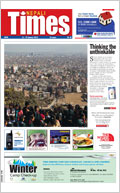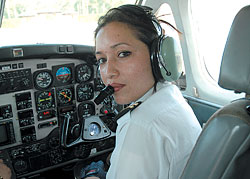 When Sony Rana got her pilot's license in 1988, she became the first Nepali woman to sit in the cockpit. Now, she has become the first Nepali woman to be certified to fly jets after she got her Boeing 757 rating recently.
When Sony Rana got her pilot's license in 1988, she became the first Nepali woman to sit in the cockpit. Now, she has become the first Nepali woman to be certified to fly jets after she got her Boeing 757 rating recently. "It has always been exhilarating and no, I have never felt awkward," says Rana who has now been flying with Royal Nepal Airlines for nearly 20 years. There are eight women pilots flying for Royal Nepal and other private carriers and the number is increasing to keep pace with the growth in the domestic airline industry. Women have found that they don't need to be stereotyped as stewardesses anymore- they can be pilots, aeronautical engineers, air traffic controllers or work in managerial positions in airlines.
"I got into piloting quite by accident really," says Hira Thapa, the most recent addition to the female pilot sorority flying for the national carrier. "I was just flipping through the papers when I saw this ad and made up my mind to go learn to fly. My parents were very supportive."
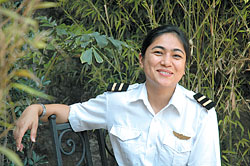 Then there are those who always dreamed of flying and from a very young age knew for certain that a pilot was what they wanted to be. "My uncle was a pilot and he used to take me to the airport and the tower. I sat in the cockpit as a little girl and I remember the first thing I liked about it was the smell of the fuel! Deep down I knew that I would fly one day," says Yashodhara Thapa of Buddha Air.
Then there are those who always dreamed of flying and from a very young age knew for certain that a pilot was what they wanted to be. "My uncle was a pilot and he used to take me to the airport and the tower. I sat in the cockpit as a little girl and I remember the first thing I liked about it was the smell of the fuel! Deep down I knew that I would fly one day," says Yashodhara Thapa of Buddha Air. For Bhawana Pant who also flies Beech 1900s for Buddha Air, her father who is a captain in Royal Nepal Airlines was the source of encouragement and inspiration. "I liked the uniforms," she laughs, "and I was completely fascinated by the notion of taking a plane up. Flying in Nepal is a challenge because of the topography." Pant flew the Cessna Grandcaravan to remote airports in western Nepal for Necon. "Flying to Simikot and Jumla then was different," she recalls, "and I remember people crowding around when they heard a woman was flying the plane."
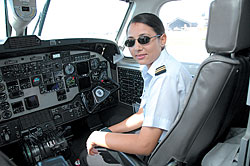 Indeed, some women pilots have found that air hours flown in the Nepal Himalaya are worth a premium and that makes it easy for them to get better paying jobs elsewhere. A few have defected to foreign airlines but most say they wouldn't give up flying in Nepal for the world.
Indeed, some women pilots have found that air hours flown in the Nepal Himalaya are worth a premium and that makes it easy for them to get better paying jobs elsewhere. A few have defected to foreign airlines but most say they wouldn't give up flying in Nepal for the world. "Every day is an experience and we get to travel all across the country," says Jeena Lingden, "people think it's a risky job. But it all depends on how professional you are and how seriously you take flying." Lingden and Sabina Shrestha of Yeti airlines regularly fly Twin Otters in and out of Phaplu, Lukla and Jufal, three of the most difficult airports in Nepal.
"I've always wanted to fly in Nepal," says Sabina, "it is the most beautiful and challenging place on earth to fly in. But you do have to make compromises between your home and career."
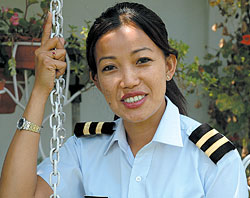 All women pilots we interviewed for this article said they got full support from their parents. And this is important since family pressure can be stressful. "It's like any other work, our lives are the same as other women professionals," says Shobha Bannerjee, an Indian pilot who lives in Nepal and flies Dornier 228s for Sita Air even though pilots are in great demand in India and salaries have gone up.
All women pilots we interviewed for this article said they got full support from their parents. And this is important since family pressure can be stressful. "It's like any other work, our lives are the same as other women professionals," says Shobha Bannerjee, an Indian pilot who lives in Nepal and flies Dornier 228s for Sita Air even though pilots are in great demand in India and salaries have gone up. Prashansa Shrestha used to fly helicopters and has now switched to Cosmic Air, flying twin-engine SAAB 340 turboprops to Pokhara. Despite turbulence and afternoon storms over the mountains during this time of year, Prashansa says pilots are trained to handle all situations. "Because of my helicopter experience I find fixed wing planes much easier to fly, although choppers were more fun," says she.
Sarina Gurung is now the only female helicopter pilot in Nepal and takes Simrik's Mi-17s to remote airports. (See also: 'Walking on air', # 205). When Sarina lands in the middle of nowhere, villagers flock to her aircraft to catch a glimpse of the "keti driverni". Says Sarina: "I love flying choppers, they are adventurous and I've always loved adventure."

